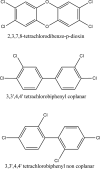Dioxin-like PCBs and endometriosis
- PMID: 20377312
- PMCID: PMC2867352
- DOI: 10.3109/19396360903381023
Dioxin-like PCBs and endometriosis
Abstract
A recent survey in the United States identified 287 different chemicals in human cord blood, demonstrating the significant exposure of women and their children to a wide array of environmental toxicants. While reducing contamination and exposure should be an international priority, it is equally appropriate to develop an understanding of the health consequences of increasing world-wide industrialization. Endometriosis, a disease of the female reproductive tract, has emerged as a disease potentially related to environmental exposures. While a number of population-based studies have suggested that a woman's exposure to dioxin-like polychlorinated biphenyls may affect her risk of developing this disease, other studies have failed to find such evidence. In the current manuscript, we will review the limited data regarding polychlorinated biphenyl congeners and endometriosis with a focus on dioxin-like toxicants. We will also discuss the potential importance of early life exposures to these toxicants on the subsequent development of endometriosis.
Figures
Similar articles
-
Polychlorinated biphenyls and its potential role in endometriosis.Environ Pollut. 2017 Oct;229:837-845. doi: 10.1016/j.envpol.2017.06.088. Epub 2017 Jul 31. Environ Pollut. 2017. PMID: 28774553 Review.
-
The risk of endometriosis and exposure to dioxins and polychlorinated biphenyls: a case-control study of infertile women.Hum Reprod. 2001 Oct;16(10):2050-5. doi: 10.1093/humrep/16.10.2050. Hum Reprod. 2001. PMID: 11574490
-
Serum dioxins, polychlorinated biphenyls, and endometriosis: a case-control study in Atlanta.Chemosphere. 2009 Feb;74(7):944-9. doi: 10.1016/j.chemosphere.2008.10.005. Epub 2008 Nov 22. Chemosphere. 2009. PMID: 19027927
-
Prenatal exposure to environmental contaminants and behavioural problems at age 7-8years.Environ Int. 2013 Sep;59:225-31. doi: 10.1016/j.envint.2013.06.014. Epub 2013 Jul 9. Environ Int. 2013. PMID: 23845936
-
Environmental exposure to polychlorinated biphenyls (PCBs) and dioxins. Consequences for longterm neurological and cognitive development of the child lactation.Adv Exp Med Biol. 2000;478:271-87. Adv Exp Med Biol. 2000. PMID: 11065080 Review.
Cited by
-
Immune interactions in endometriosis.Expert Rev Clin Immunol. 2011 Sep;7(5):611-26. doi: 10.1586/eci.11.53. Expert Rev Clin Immunol. 2011. PMID: 21895474 Free PMC article.
-
Exposure to the environmental endocrine disruptor TCDD and human reproductive dysfunction: Translating lessons from murine models.Reprod Toxicol. 2017 Mar;68:59-71. doi: 10.1016/j.reprotox.2016.07.007. Epub 2016 Jul 14. Reprod Toxicol. 2017. PMID: 27423904 Free PMC article. Review.
-
Environmental Endocrine Disruptors and Endometriosis.Adv Anat Embryol Cell Biol. 2020;232:57-78. doi: 10.1007/978-3-030-51856-1_4. Adv Anat Embryol Cell Biol. 2020. PMID: 33278007 Free PMC article. Review.
-
The Potential Relationship Between Environmental Endocrine Disruptor Exposure and the Development of Endometriosis and Adenomyosis.Front Physiol. 2022 Jan 28;12:807685. doi: 10.3389/fphys.2021.807685. eCollection 2021. Front Physiol. 2022. PMID: 35153815 Free PMC article. Review.
-
Not Having Been Breastfed May Protect Chinese Women From Developing Deep Infiltrating Endometriosis: Results From Subgroup Analyses of the FEELING Study.Reprod Sci. 2019 Aug;26(8):1158-1167. doi: 10.1177/1933719118820469. Epub 2019 Jan 22. Reprod Sci. 2019. PMID: 30669944 Free PMC article.
References
-
- Anger DL, Foster WG. The link between environmental toxicant exposure and endometriosis. Front Biosci. 2008;13:1578–93. - PubMed
-
- Aoki Y. Polychlorinated biphenyls, polychlorinated dibenzo-p-dioxins, and polychlorinated dibenzofurans as endocrine disrupters--what we have learned from Yusho disease. Environ Res. 2001;86:2–11. - PubMed
-
- Arruda MS, Petta CA, Abrao MS, Benetti-Pinto CL. Time elapsed from onset of symptoms to diagnosis of endometriosis in a cohort study of Brazilian women. Hum Reprod. 2003 Apr;18(4):756–9. - PubMed
-
- Axelrad Daniel A., Goodman Stephanie, Woodruf Tracey J. PCB body burdens in US women of childbearing age 2001-2001: An evaluation of alternate summary metrics of NHANES data. Environ Res. 2009 May;109(4):368–78. Epub 2009 Feb 28. - PubMed
Publication types
MeSH terms
Substances
Grants and funding
LinkOut - more resources
Full Text Sources
Medical

